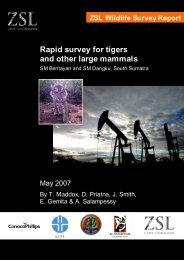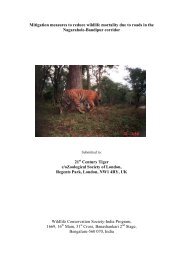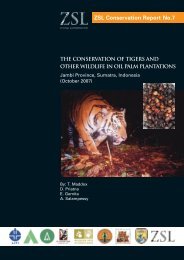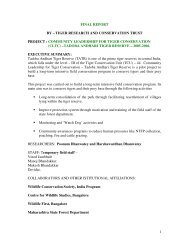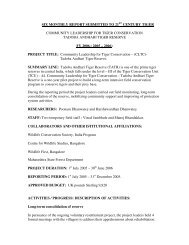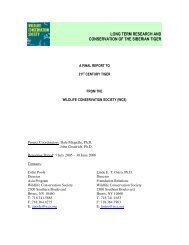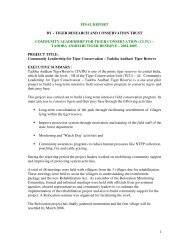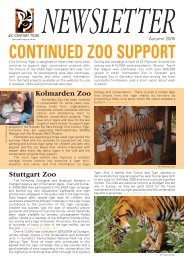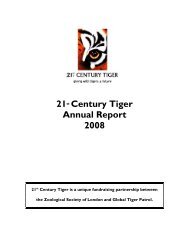CLTC Anshi-Dandeli final report 2005 - 21st Century Tiger
CLTC Anshi-Dandeli final report 2005 - 21st Century Tiger
CLTC Anshi-Dandeli final report 2005 - 21st Century Tiger
You also want an ePaper? Increase the reach of your titles
YUMPU automatically turns print PDFs into web optimized ePapers that Google loves.
Contents Page No<br />
Project details<br />
Acknowledgements 2<br />
Executive Summary 3<br />
Project objectives<br />
Description of activities<br />
Goals/Activities for the next year<br />
Appendices 12<br />
2<br />
4<br />
4<br />
11
st<br />
Final <strong>report</strong> to 21 <strong>Century</strong> <strong>Tiger</strong><br />
COMMUNITY LEADERSHIP FOR TIGER CONSERVATION - ANSHI- DANDELI.<br />
Project Title: Community Leadership for <strong>Tiger</strong> Conservation - <strong>Anshi</strong>- <strong>Dandeli</strong>.<br />
Project Leader:<br />
Balachandra Hegde, Sahyadri Wildlife and Forest Conservation Trust (SWIFT)<br />
Staff: Permanent: nil, Temporary field staff: 2<br />
Collaborators and institutional affiliations:<br />
1. Wildlife Conservation Society, India Program<br />
2. Center for Wildlife Studies, Bangalore<br />
3. Wildlife First, Bangalore<br />
4. Joida Taluka Journalists' Association<br />
5. Forestry College, Sirsi<br />
Project duration: July 1, 2004 June 30, <strong>2005</strong><br />
Acknowledgements: Community Leadership for <strong>Tiger</strong> Conservation was made possible with the<br />
st<br />
funding support from 21 <strong>Century</strong> tiger. The project team wishes to thank the donors. The project team<br />
acknowledges the support and encouragement received from Chief Wildlife Warden, Karnataka Forest<br />
Department. The project team also thanks Park warden and entire staff of <strong>Anshi</strong> National Park and<br />
<strong>Dandeli</strong> Wildlife Sanctuary for providing active support and help while implementing this project.
Executive Summary:<br />
Community Leadership for <strong>Tiger</strong> Conservation (<strong>CLTC</strong>) is a continuation of the ongoing conservation and<br />
st<br />
education project supported by 21 <strong>Century</strong> <strong>Tiger</strong> in <strong>Anshi</strong> National Park and <strong>Dandeli</strong> Wildlife Sanctuary to<br />
conserve some of the key tiger habitats in the northern part of the level1 <strong>Tiger</strong> Conservation Unit-55, (Dinerstein<br />
et al. 1997) in the Western Ghats of Karnataka, India.<br />
During the <strong>report</strong>ing period, 48 community awareness and school education programs were conducted for local<br />
communities and students residing in and around the protected areas (PAs). The project team organized<br />
activities to educate people about the ill effects of forest fires, extraction of Non Timber Forest Produce (NTFP)<br />
and hunting. Initiatives started in the last <strong>report</strong>ing period to include other potential tiger habitats around the<br />
reserve were continued. Activities related to the rationalization of park boundary, voluntary resettlement of<br />
villagers from within the PAs, and liaison and follow up with the government agencies were also continued<br />
during the project period.
Project Objectives:<br />
The <strong>CLTC</strong>-<strong>Anshi</strong> <strong>Dandeli</strong> project aimed to achieve the following objectives during the period:<br />
Continue conservation efforts initiated under <strong>CLTC</strong> during the previous project year.<br />
Mobilize community support and build local conservation leadership in the villages to support a<br />
long-term conservation activity in the area.<br />
Continuously liaise with the senior forest department officials through formal and informal<br />
interaction and provide inputs for improvement of protection mechanism.<br />
Continue watchdog activities, to monitor and <strong>report</strong> activities, which are detrimental to wildlife and<br />
their habitat.<br />
Provide inputs for consolidation of habitat by the addition of potential wildlife habitats around the<br />
reserves, and follow up with the concerned government agencies.<br />
Description of Activities Undertaken:<br />
1. Continue conservation efforts initiated under <strong>CLTC</strong> during the previous project year.<br />
a) Voluntary resettlement: During the previous <strong>report</strong>ing period (2003-2004), several meetings were<br />
held with local communities, followed by field visits to other PAs where voluntary resettlements<br />
processes have already been initiated. Convinced by the success of resettlements in other PAs such as<br />
Bhadra <strong>Tiger</strong> Reserve, Karnataka, some of the villagers inside the <strong>Dandeli</strong> Wildlife Sanctuary and <strong>Anshi</strong><br />
National Park also showed interest in being resettled and submitted a memorandum to the administration<br />
demanding resettlement. However, procedures of resettlement (e.g. preparing the draft proposal) had not<br />
been initiated then.
The support provided to local communities demanding resettlement during the last <strong>report</strong>ing period<br />
was continued during this <strong>report</strong>ing period. A committee for drafting the proposal for resettlement was<br />
constituted by the Deputy Conservator of Forests, which included villagers, forest officials and the<br />
project leader. This committee has drafted the project proposal, which will be sent to the government<br />
shortly. The project leader has provided many inputs, including data on the number of families to be<br />
resettled, revenue land holdings, and other properties that are liable for compensation, which were<br />
collected by him with the help of local youths. The project leader also helped the local people in<br />
articulating their demands for resettlement.<br />
2. Mobilizing Community Support for <strong>Tiger</strong> Conservation<br />
a) Community awareness programs:<br />
Fourteen formal meetings and several informal meetings were conducted with local villagers residing<br />
within the enclosures of <strong>Dandeli</strong> Wildlife Sanctuary (DWS) and <strong>Anshi</strong> National Park (ANP) during the<br />
<strong>report</strong>ing period. During these meetings issues such as voluntary resettlement of villages, crop damage<br />
by wildlife and compensation support by the government, local support to the forest department's<br />
protection system and minimizing human impacts on forests were discussed.<br />
These educational meetings were meant to create awareness and conceive a strategy for minimum<br />
impact harvesting of NTFP. The negative impacts of over-harvesting and destructive harvesting<br />
methods were highlighted during these meetings.<br />
The project leader visited all villages which are prone to crop raiding by elephants and other wildlife.<br />
The various aspects of the problem were discussed, and the project leader helped mediate between the<br />
villagers and the forest department. The project leader ensured that the supply of firecrackers used to<br />
drive crop-raiding elephants away was done well before the crop-raiding season.
) Slide Shows:<br />
Eighteen public awareness campaigns with slide shows were conducted in villages<br />
located inside the reserves. All these programs were conducted during local festivals,<br />
cultural events and other social meetings. The importance of tiger conservation in the<br />
region, and responsibilities of local communities towards conservation were<br />
discussed in each of the meetings. Over 600 people from nine villages attended these<br />
slide shows.<br />
c) Video shows:<br />
A total of 11 half-day conservation events were organized in villages inside the<br />
reserves. Video shows on wildlife conservation were screened and talks accompanied<br />
by a PowerPoint presentation on <strong>Dandeli</strong> and <strong>Anshi</strong> reserves were conducted.<br />
Students and teachers along with local villagers attended these events. A field trip into<br />
forests was also organized during each of these events, where the students were<br />
introduced to the flora and fauna of the area. Discussions on tiger conservation were<br />
initiated in which villagers and students participated actively after the half-day events.<br />
In all about 350 students and teachers from various schools, and about 75 villagers<br />
participated actively in these events.<br />
d) Fire protection campaign:<br />
Creating awareness about forest fires was one of the major activities carried out during<br />
the <strong>report</strong>ing period. Posters and pamphlets in the local language about the negative<br />
effects of fire on forests and wildlife were distributed to the villagers. Local youth<br />
were encouraged to immediately inform the forest department when fires occurred, so<br />
that the department staff could take prompt action to extinguish the fires.<br />
e) Religious Festivals: Two religious festivals are conducted annually inside the<br />
reserve with around 100,000 people participating in one of them. At this time,<br />
people from all over the state visit the temple inside the reserve. Pilgrims,<br />
especially from neighboring non-forested areas, use this visit to collect wood, cane<br />
and bamboo to make agricultural implements. As part of the project, these<br />
occasions were used to spread awareness about
the importance of these reserves, and pamphlets with conservation messages were<br />
designed and distributed to the visiting pilgrims.<br />
f) Nature camps:<br />
Five nature camps were conducted for students of primary schools within the PAs and<br />
from the surrounding area. Issues pertaining to the wildlife reserves, importance of<br />
tiger and forest conservation were introduced to the students and discussion were<br />
initiated. A small field trip to the forests, to enable the students to gain exposure to<br />
wildlife, and to see first-hand the important role of forests in hydrology and other<br />
processes, was also conducted during each camp. The negative impacts to forests and<br />
wildlife from NTFP harvesting and local hunting were emphasized. About 121<br />
students and about 25 villagers participated in these nature camps.<br />
g) Support to local communities:<br />
Health camps:<br />
Five health camps were conducted in remote villages situated inside the DWS and<br />
ANP in collaboration with the Joida Taluka Journalists' Association. The project<br />
mobilized doctors from government hospitals to visit the villages and provided health<br />
check-ups. Such camps were conducted in Siddoli (DWS), Kundal (ANP) and Diggi,<br />
Terali, Shiroli villages (on the periphery of the reserves). These remote villages gained<br />
access to government hospitals for the first time, and about 150 people benefited from<br />
these health camps. These camps will help in building goodwill, among these villages<br />
inside or on the periphery of the PAs, towards conservation efforts underway inside<br />
the reserve.<br />
Interaction with other governmental officials:<br />
Six meetings of local villagers with government officers from other departments were<br />
organized by the project leader at villages situated inside the park. The Tahsildar<br />
(Tehsil Revenue Officer) and other officers camped at the villages and provided<br />
services such as provision of land records, ration cards and other facilities to the<br />
villagers. About 200 people received these services during these camps.
These villages are situated in the interior forests (about 25 - 40 km away from the nearest modern<br />
facilities) and have no basic amenities. These programs help instill confidence in the project leader<br />
and build a strong rapport, which is likely to help reduce conflicts in the future, and is extremely<br />
important if the resettlement project is to be carried out successfully.<br />
Hydroelectric Projects: The government is considering a proposal to construct a series of<br />
hydroelectric dams across streams flowing in Uttara Kannada district. A total of 11 dams have been<br />
proposed for tributaries of three major east flowing rivers originating in the Western Ghats of the<br />
district. Out of these, two of the proposed dams will be inside the <strong>Anshi</strong> National Park and two inside<br />
the <strong>Dandeli</strong> Wildlife Sanctuary. The other seven dams will be situated in reserved forest areas,<br />
submerging a total of over 6000 ha of pristine evergreen and semi-evergreen forests of the Western<br />
Ghats-one of the global biodiversity hot spots. Project leader provided substantial technical inputs<br />
and support to local advocacy groups who were campaigning against this ill-conceived<br />
developmental project. He also participated in these local campaigns and helped mobilize public<br />
support against these projects.<br />
3. Continuously liaise with the senior forest department officials through formal and informal<br />
interactions and provide inputs for improvement of protection mechanism.<br />
Interaction with forest department staff:<br />
Regular formal and informal meetings were held with forest officials to discuss conservation issues.<br />
During this <strong>report</strong>ing period, a number of meetings were held with different officials, the details of<br />
which are given below:<br />
Forest official No of meetings held<br />
Range Forest Officer 72 (5 different range officers)<br />
Deputy Conservator of Forests (DCF) 21<br />
Conservator of Forests (CF) 12<br />
Principal Chief Conservator of Forests<br />
(PCCF) and Chief Wildlife Warden 4
These meetings were used to communicate conservation problems observed in the field to<br />
department officials, and to follow up on the proposals for resettlement and boundary<br />
rationalization.<br />
The project leader also provided substantial inputs to forest department officials towards<br />
habitat improvement and wildlife management measures. Forest department officials<br />
often consulted the project leader on these issues.<br />
4. Continue watchdog activities, to monitor and <strong>report</strong> activities, which are<br />
detrimental to wildlife and their habitat.<br />
Building up of a volunteer group:<br />
Under the guidance of the project leader, nine youths from villages inside the reserves and<br />
15 from other areas have been participating actively in conservation efforts such as<br />
conducting nature camps and bicycle rallies. Five of them are regularly involved in<br />
various conservation activities. Many of these youths were first introduced to wildlife<br />
conservation in the previous <strong>report</strong>ing years, some of them as long ago as three years, and<br />
continue to participate actively. Five journalists, (both freelance and full-time) have<br />
voluntarily involved themselves in conservation efforts and write regularly on<br />
conservation issues to spread awareness.<br />
Several local youths now provide the project leader with information on illegal activities<br />
such as hunting, narcotics cultivation, timber smuggling, dynamiting of streams for fish,<br />
poisoning of tiger kills, and encroachments into the reserve, which is then passed on to the<br />
forest department. The project leader has maintained a good rapport with these people, and<br />
has been able to bring to the department's attention substantial amount of information on<br />
these activities.
5. Provide inputs for consolidation of habitat by the addition of potential wildlife habitats<br />
around the reserves, and follow up with the concerned government agencies.<br />
Increasing the available tiger habitat:<br />
Around ANP and DWS exist fairly large forested areas with excellent potential to support tiger<br />
and prey populations. These areas are currently designated as reserved forests and<br />
consequently receive a lower level of protection. Inclusion of these areas to the two PAs will<br />
2<br />
help consolidate the larger landscape and add an additional 300 km to the existing area. A<br />
boundary rationalization proposal towards this end, prepared by the project leader and Mr.<br />
Sanjay Gubbi during the previous <strong>report</strong>ing period, has been accepted by the forest department,<br />
and has now been sent to the state government for approval. The project leader is following up<br />
with senior forest department officials to implement the proposed boundary rationalization.<br />
The project leader has also been providing additional information as and when required by the<br />
government.<br />
EXPLORATORY ACTIVITIES:<br />
Project leader participated as an instructor in line transect field surveys conducted by Centre for<br />
Wildlife Studies, for large mammals conducted at Nagarahole National Park, Bandipur<br />
National Park and Bhadra <strong>Tiger</strong> reserves. Project leader also participated in the activities<br />
carried out by Karnataka Birders Network (NKBN) and Uttara Kannada Jilla Parisara<br />
Samrakshanaa Samiti.<br />
PROBLEMS AND CONSTRAINTS:<br />
The project leader met with a vehicle accident and could not actively carry out conservation<br />
activities during his recovery period of 45 days. However, conservation field activities were<br />
continued by volunteers during this time.
GOALS / ACTIVITIES FOR THE NEXT YEAR:<br />
1. To conduct education programs on wildlife conservation to mobilize public<br />
support and build local conservation leadership in the villages to support<br />
Long- term tiger conservation in the area.<br />
2. To educate people about the benefits of relocating to areas outside existing<br />
wildlife reserves, motivate them into action, and to support both local people and<br />
the forest department in the design and implementation of a fair and just<br />
resettlement plan.<br />
3. To interact with the local people and forest officials to improve the on-ground<br />
protection for tigers, their prey and their habitat.<br />
CONSERVATION ACCOMPLISHMENTS:<br />
• A boundary rationalization proposal developed by the project leader to include<br />
additional area into the park has been sent by the forest department to the<br />
government of Karnataka for <strong>final</strong> approval.<br />
• A proposal for resettlement has been prepared. The project leader is actively<br />
involved with government agencies to obtain approval for the proposal.<br />
• Though difficult to measure, the education activities, as well as the medical<br />
camps have significantly increased awareness among local communities, as<br />
evident from the information received by the project leader on illegal activities in<br />
the PAs from the villagers, the response to the nature camps and a tangible<br />
change in attitudes towards conservation.<br />
• A small group of wildlife enthusiasts has been set up, comprising of locals from<br />
within the PAs and from the surrounding areas. Under the guidance of the project<br />
leader, this group has become increasingly active in conservation efforts.
Appendix I<br />
Photo-images of project activities during July 2004 June <strong>2005</strong>
c Sanjay Gubbi
Appendix II<br />
Maps
India<br />
%<br />
Locatio n o f<br />
an i i dl f Di si<br />
D del W l i e vi on Map 1<br />
Western Ghats 50 0<br />
0 250<br />
Kilomet ers<br />
India<br />
<strong>Dandeli</strong> Wildlife Sanctuary Anhs hi Natio nal Park<br />
Dandel i Wildlife Division Goa<br />
Buffer Area<br />
Karnataka <strong>Tiger</strong> Conse rvation Unit (TCU)- 55<br />
10<br />
0 5<br />
100<br />
0 50<br />
Kilometers Kilometers Tamilna du<br />
Keraa l<br />
Sou rce: Sahyad ri Wildlife and Forest Conservation Trus t(SWIFT)/ Centre for Wildlife Studie s (CW S)
%<br />
<strong>Dandeli</strong> Area proposed<br />
to be added to <strong>Anshi</strong> National Park<br />
Phase 1<br />
Bommanaha lli<br />
Patoli Cross<br />
Kulgi oida<br />
Joida J<br />
Ambikanagar Kumbarwada Nagazari Gund<br />
Kaei nrnai d<br />
Goa State<br />
Kali nadi<br />
Ulvi<br />
ns i<br />
A h<br />
Shivapura <strong>Anshi</strong> National Park<br />
Saka li halla Sulgeri<br />
andel W ldli e S ary<br />
D i i f anctu<br />
Balemane Are a propose d t o b e added to Ans hi N. P.<br />
r<br />
Devaka<br />
od all am<br />
K as i D<br />
Kadra Western Ghats ridgeline =<br />
Kadrabackwater Kaiga 0 5 10<br />
Kilometers Sou rce: Sahyadr i Wi ldlife and Forest Conservation Trust (SWIFT)/ Centre for Wildlife St udies ( CWS)
Ulvi<br />
%<br />
atne(Bido<br />
Ulvi<br />
<strong>Dandeli</strong> Wildlife Division<br />
Map 13<br />
Shivapur<br />
Kumri<br />
Chilmi<br />
Hebbal<br />
Gaddemane<br />
Shele<br />
Neturga<br />
Kodthalli<br />
Kumri<br />
Satoddi Falls<br />
Birkol<br />
2<br />
0 1<br />
Sulgeri<br />
Kilometers<br />
Revenue villages<br />
Villages proposed for voluntarary rehabilitation<br />
Source: Sahyadri Wildlife and Forest Conservation Trust (SWIFT) / Centre for Wildlife Studies(CWS)




